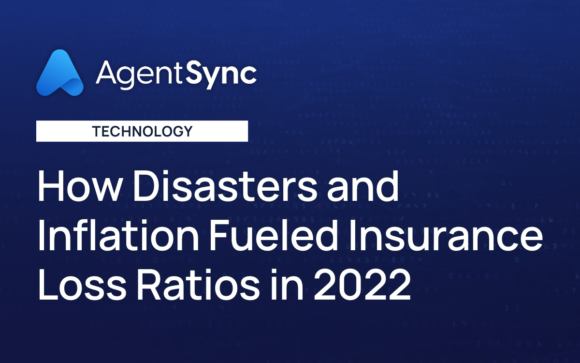This article is part of a sponsored series by AgentSync.

It’s no longer just a hypothesis that more and larger natural disasters, along with general inflation and social inflation, are driving up insurers’ claims costs. New data shows loss ratios rose in 2022, specifically for personal lines property and casualty insurers, to the tune of a $26.5 billion loss. With claims costs continuing to rise, along with more assets located in areas at high risk for catastrophic disasters, insurers may be wondering what they can do to reduce expenses that are under their control.
2022 was a hard year for insurance losses
It seems like each year tops the one before it when it comes to the frequency and severity of storms, fires, and other natural disasters. One large difference in 2022, however, was the presence of high inflation across the U.S. and the world. This spelled bad news for U.S. property and casualty insurance carriers, which reported a combined loss ratio of 104, up from 100 in 2021, according to AM Best.
Large-scale catastrophic events
Hurricane Ian, Hurricane Fiona, Texas hailstorms, tornadoes and flooding in the southeast and midwest, and fires in the western U.S. are just the tip of the iceberg for 2022’s devastation. The National Centers for Environmental Information (NCEI) says there were 18 weather or climate-related disaster events in 2022 that each incurred over $1 billion in losses.
While 2022 wasn’t the overall costliest year in recent memory in terms of natural disasters (that honor goes to 2017), it ranks third overall since 1980, and the insurance industry incurred particularly high losses because of the coinciding inflation surge.
Rampant inflation and rising costs
Inflation began to rise dramatically month over month around March of 2021, peaking at 9.1 percent in June 2022, according to data from Trading Economics and the U.S. Bureau of Labor Statistics. And this rise in inflation impacted more than the gost of gas and milk.
For insurers, claims costs spiked as supply chain disruptions and inflation made it more expensive to replace homes, cars, and other insured assets lost in 2022’s devastating natural and man-made disasters. Data from Swiss Re estimates around $125 billion in insured losses from natural catastrophes and an additional $7 billion from man-made ones across the U.S. during 2022. As staggering as that number is, Swiss Re estimates total losses (not just insured losses) amounted to $284 billion.
How insurance carriers can reduce losses
Bringing in more money than it pays out is what drives an insurance company’s profitability. This can come from a combination of factors like collecting more in premiums, paying out less in claims, and reducing operating costs. Insurance carriers looking to reduce loss ratios should consider some of the following potential practices.
Price policies to accurately reflect risk
Affordability is certainly a concern for insurance companies that want to attract and keep customers. But no insurer can survive long-term if policies aren’t priced to reflect the level of risk the company’s taking on. This might mean raising premiums in the highest-risk areas, or even leaving some markets entirely if they’re simply too risky to underwrite. This isn’t great news for the consumers who rely on insurance protections.
On the other hand, the inability to get insurance due to living in an extremely high-risk location could incentivize people to relocate out of flood zones (for example) as is happening in the city of Milwaukee. If fewer insured assets exist in the riskiest places, insurers can accurately price policies without going so high that they scare away customers.
Retain customers
Common wisdom is that it’s more expensive to acquire new customers than to retain existing ones. Aside from those customers who are just too high of a risk to continue insuring (see our previous point), it’s a good idea to do what you can to keep – and even increase business with – your current customers. And sure, insurance carriers do sometimes sell directly to customers, which puts 100 percent of the retention burden on you. But you also might rely on your downstream distribution channel partners to keep those customers happy.
If your distribution channel includes independent agents and agencies, one thing you can do is work on keeping those relationships healthy so agents want to place more business with you, and continue placing it year after year.
Tighter terms and conditions
Insurance carriers can reduce some of what they pay out in claims by tightening up their policies’ terms and conditions. This might mean increasing deductibles, having lower benefit maximums, or adding exclusions. It also may include incentives for customers who perform risk-mitigating activities or exclusions for those who don’t. If you go in this direction to reduce costs, it’s important to make sure customers understand what’s in their policy contracts so they aren’t ill-informed or taken by surprise by a denied claim later.
Greater focus on risk assessment and management
We’ve said it before: Prevention is the new solution. For insurance companies that want to reduce losses and be more profitable, paying less out in claims because their customers incur fewer losses is a win-win. There are plenty of ways insurers can focus on risk reduction: from new technology like telematics to a good, old-fashioned site visit with a risk management consultant.
Reduce operating expenses
Insurance carrier operating expenses are no joke. One McKinsey study from 2015 found that operating expenses at the industry’s top-performing carriers were typically around 60 percent lower than operating expenses at the lowest-performing companies.
While we’re not talking about health insurance specifically, another example of the oversized cost of insurance operating expenses is how much of every healthcare dollar is spent (or even wasted) on administrative expenses. Research shows that it’s between 15 and 30 percent, just in case you were wondering – with nearly half of what’s spent estimated to be wasteful.
In nearly every case, reducing operating expenses comes down to doing more with less, being more efficient, more productive, and less wasteful. It’s no surprise that technology plays a large role in accomplishing these objectives at insurance carriers.
How can insurance carriers reduce operating costs with insurance technology?
However you approach the question, the answers boil down to some version of these five points.
1. Optimize operations
Operational functions like IT, finance, payroll, billing, and legal can account for a large portion of an insurance company’s budget. If each of these departments isn’t running efficiently, the result is wasted time, effort, and money. To start with, conduct an audit of how each department functions and which staff are doing what tasks. See if there’s room to automate some of the busy-work to make room for in-house experts to perform higher-level work.
2. Automate functions whenever possible
Across the entire business, from sales and marketing to underwriting, people are likely doing work by hand that could be much more quickly done by modern technology. Not only does automating functions save time and reduce room for human error, it also makes your humans happier because they aren’t stuck doing parts of their jobs that feel manual and repetitive. Having happier people translates into better employee attraction and retention, which (surprise, surprise!) lowers operating costs.
3. Leverage artificial intelligence (AI) and machine learning (ML)
Artificial intelligence isn’t going to replace your valuable human staff. It’s just going to empower them to work better, and on the types of things that only humans can do. Rather than expecting AI to handle the entire underwriting or claims-management process from start to finish, it will realistically be able to speed up pieces of these processes.
For example, AI can help an insurance carrier quickly sift through more insurance applications than a person ever could in one day, and flag things for human review that need to be looked at more closely. Speeding up these processes and creating operational efficiencies benefits employees, customers, your reputation, and profit margins.
4. Reduce agent onboarding time and costs
One major operational cost for insurance carriers is the appointment fees you pay to each state for each licensed producer. This expense is often unnecessary given that most producers you appoint won’t even go on to sell a policy! To help, many states allow carriers to use Just-in-Time (JIT) appointments so that you only pay for producers who’re actually selling on your behalf. But tracking those producers and when, where, and what each one is selling – manually – is no easy feat! This is just one area of many where technology can help reduce agent onboarding time and costs.
5. Use insurance technology to automate and manage producer license compliance
From carriers to MGAs and MGUs to insurance agencies and individual agents and producers, everyone has an obligation to ensure producers are properly licensed and selling in compliance with all applicable laws. This is easier said than done, particularly once you’ve moved beyond a single producer in a single state selling a single product.
The time-consuming nature of managing producer compliance often means that insurance carriers have far too many people devoting far too many hours to this work when everyone involved would rather be doing higher-level activities. It may mean your in-house experts’ time is wasted on tedious tasks. Or it may mean the quantity of license verifications needed are far beyond your teams’ capacity, leading to regulatory risks. It could even mean producers are waiting weeks or months to be ready to sell, which isn’t good for them and can hurt your relationship with your downstream agency and producer partners.
On the other hand, using technology to automate and manage producer license compliance, including carrier appointments, can lead to a happier team and better partner relationships.
AgentSync helps insurance carriers reduce operating costs with modern insurance infrastructure
We can’t make your loss ratios go down by controlling the weather. But AgentSync can help insurance carriers, MGAs, MGUs, and everyone else in the insurance distribution channel stay in compliance without any heavy lifting. You can reap the benefits of giving your compliance staff time back in their day and enabling your agency partners with real-time, automated compliance. Ready to see how? Contact us or watch a demo today.
Topics Profit Loss
Was this article valuable?
Here are more articles you may enjoy.



 Massachusetts Approves Reorganizations, Mergers for Andover Companies
Massachusetts Approves Reorganizations, Mergers for Andover Companies  Head of EEOC Urges White Men to Report Discrimination
Head of EEOC Urges White Men to Report Discrimination  Senators Launch Probe Into Demotech’s Ratings in Florida
Senators Launch Probe Into Demotech’s Ratings in Florida  Viewpoint: Artificial Intelligence Is Rewriting the Rules for Commercial Lines
Viewpoint: Artificial Intelligence Is Rewriting the Rules for Commercial Lines 


